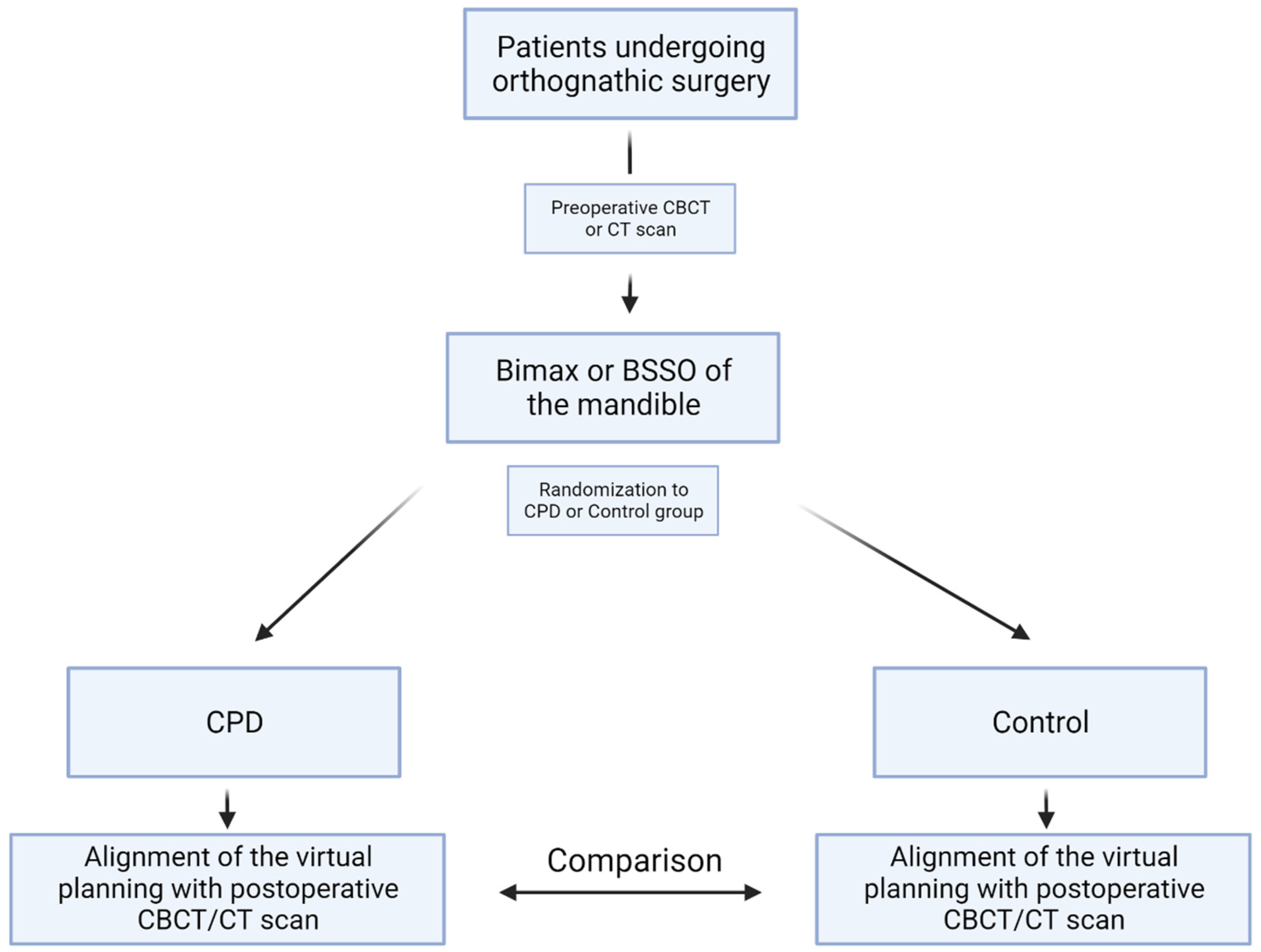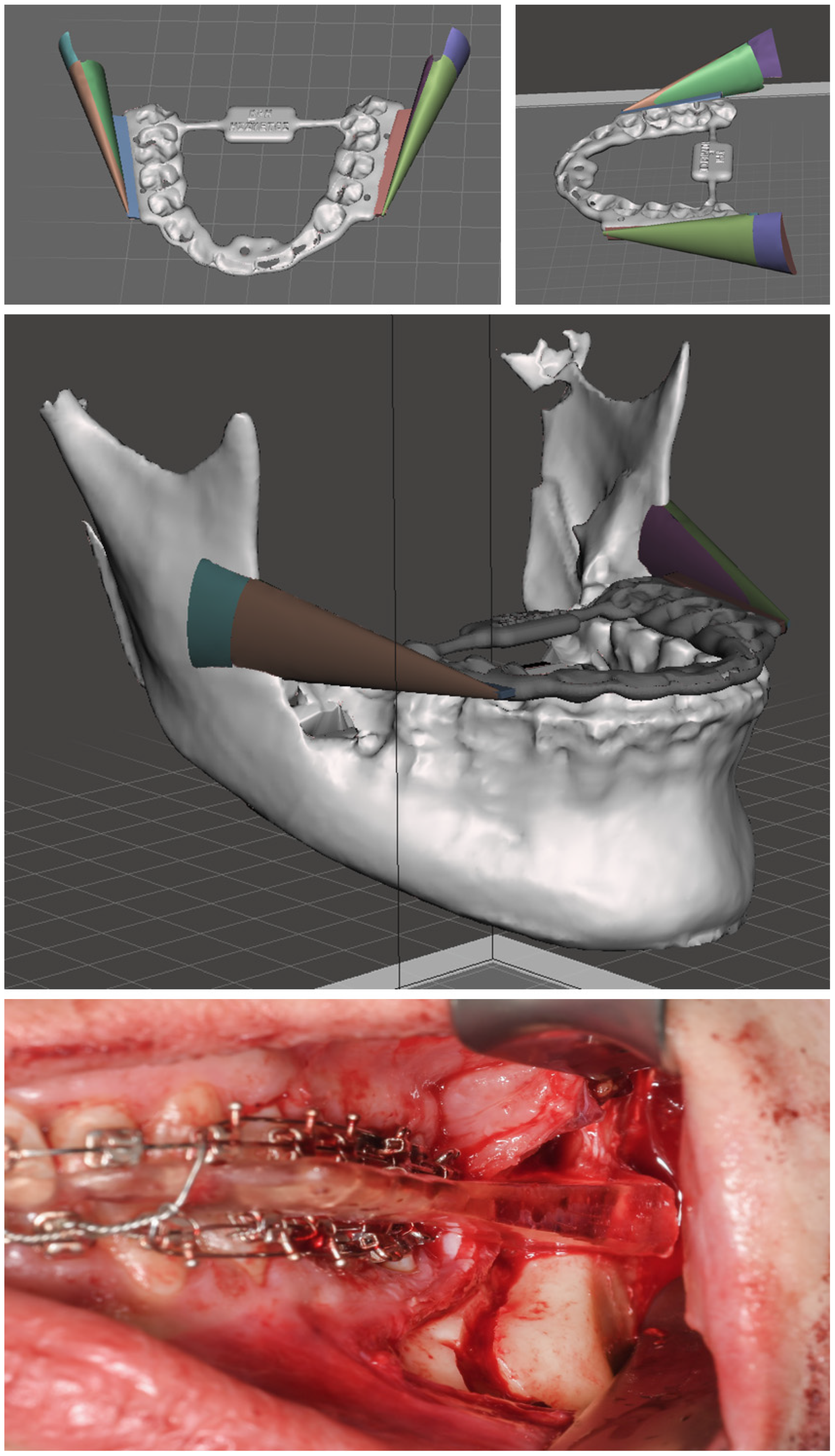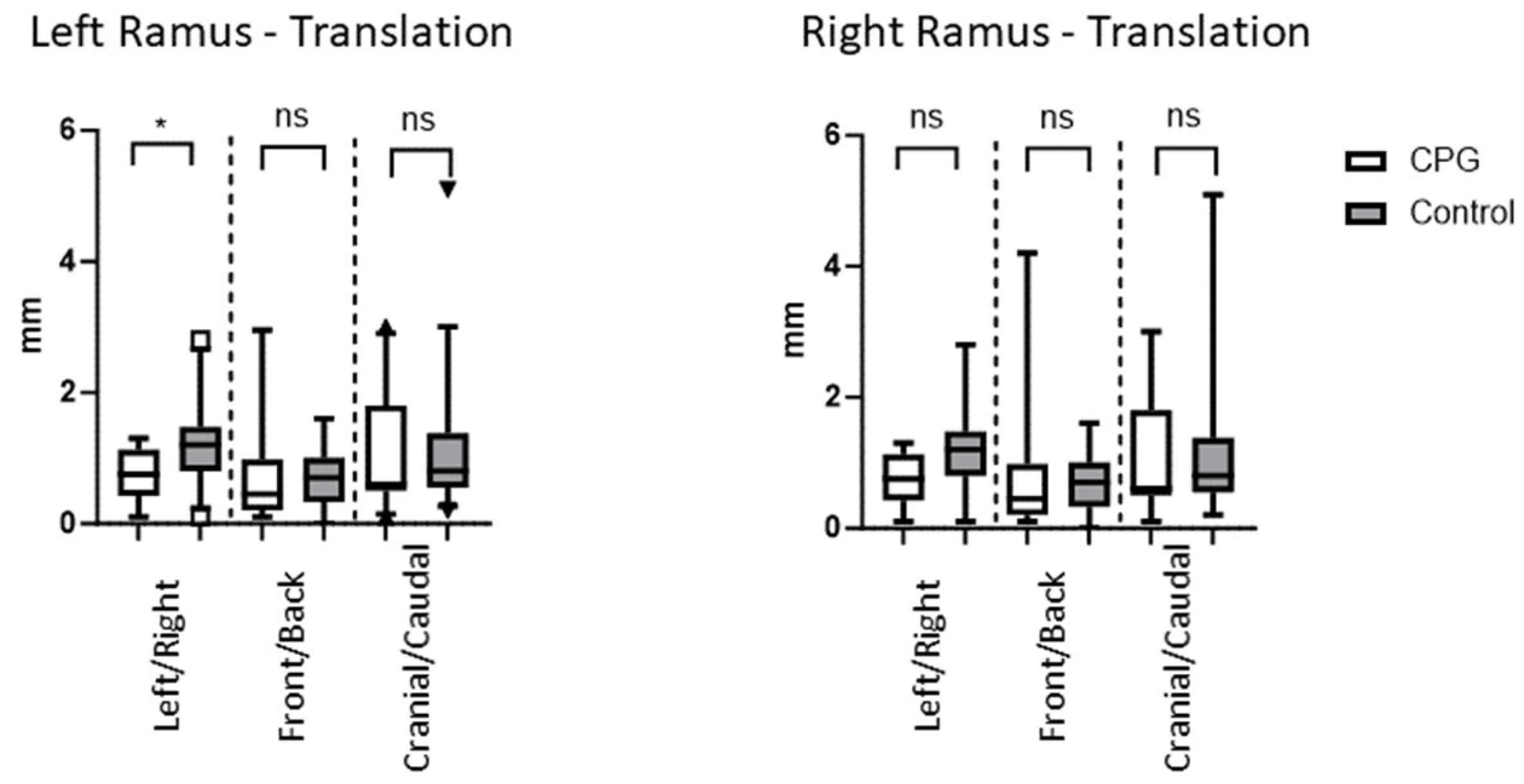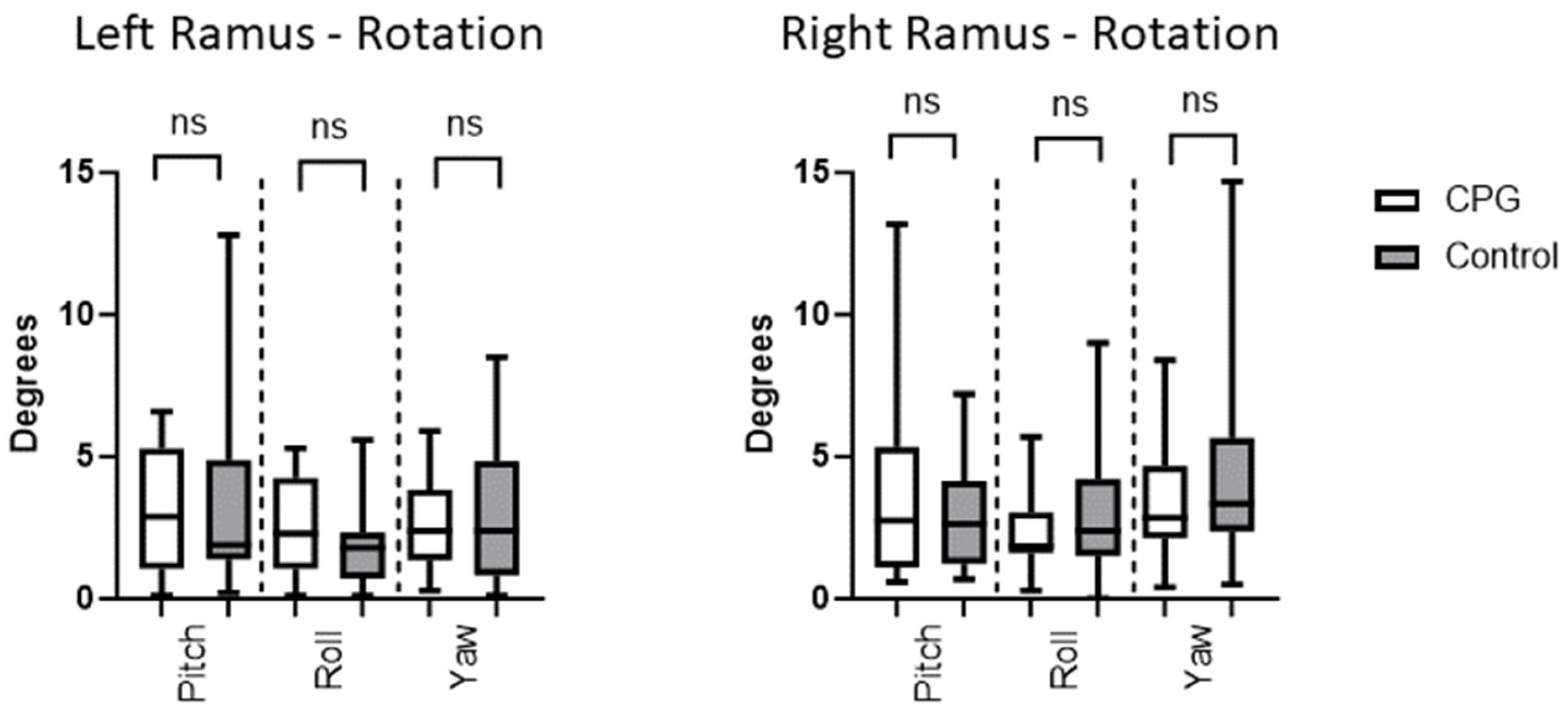Comparison of Patient-Specific Condylar Positioning Devices and Manual Methods in Orthognathic Surgery: A Prospective Randomized Trial
Abstract
1. Introduction
2. Materials and Methods
2.1. Study Design
- Age of 18 or older
- Patients undergoing orthognathic surgery in the form of BSSO of the mandible either as part of a bimaxillary operation or an isolated osteotomy of the mandibleExclusion criteria were:
- Patients who failed or were unable to comply with the study protocols after inclusion (e.g., intraoperative complications like bad split, operation splint failure, or an evaluation of cone-beam computed tomography (CBCT) scan proving impossible)
2.2. Planning and Surgical Technique
2.3. Manual Condylar Positioning
2.4. Condylar Positioning Devices
2.5. Intra- and Postoperative Management
2.6. Measurement
2.7. Data Processing and Statistics
3. Results
3.1. Ramus Position: Comparison of Postoperative Results with the Virtually Planned Position
3.2. Comparison of Translations and Rotations in Mandibular Advancement and Setback
4. Discussion
5. Conclusions
Author Contributions
Funding
Institutional Review Board Statement
Informed Consent Statement
Data Availability Statement
Conflicts of Interest
References
- Lee, Y.C.; Sohn, H.B.; Park, Y.W.; Oh, J.-H. Evaluation of postoperative changes in condylar positions after orthognathic surgery using balanced orthognathic surgery system. Maxillofac. Plast. Reconstr. Surg. 2022, 44, 11. [Google Scholar] [CrossRef]
- Costa, F.; Robiony, M.; Toro, C.; Sembronio, S.; Polini, F.; Politi, M. Condylar positioning devices for orthognathic surgery: Please includeA literature review. Oral. Surg. Oral. Med. Oral. Pathol. Oral. Radiol. Endod. 2008, 106, 179–190. [Google Scholar] [CrossRef]
- Ueki, K.; Nakagawa, K.; Marukawa, K.; Takazakura, D.; Shimada, M.; Takatsuka, S.; Yamamoto, E. Changes in condylar long axis and skeletal stability after bilateral sagittal split ramus osteotomy with poly-L-lactic acid or titanium plate fixation. Int. J. Oral. Maxillofac. Surg. 2005, 34, 627–634. [Google Scholar] [CrossRef]
- Kaur, A.; Rattan, V.; Rai, S.; Singh, S.P.; Kalra, P.; Sharma, S. Changes in condylar position after orthognathic surgery and its correlation with temporomandibular symptoms (TMD)—A prospective study. J. Craniomaxillofac. Surg. 2022, 50, 915–922. [Google Scholar] [CrossRef]
- Chow, W.; He, Z.; Liu, Y.; Song, J.; Xu, C.; Luo, E. Intraoperative condylar positioning techniques on mandible in orthognathic surgery. Orthod. Craniofac Res. 2022, 25, 449–458. [Google Scholar] [CrossRef]
- Mazzone, N.; Matteini, C.; Incisivo, V.; Evaristo, B. Temporomandibular joint disorders and maxillomandibular malformations: Role of condylar “repositionin” plate. J. Craniofac Surg. 2009, 20, 909–915. [Google Scholar] [CrossRef] [PubMed]
- Sanroman, J.F.; Gonzalez, J.M.G.; del Hoyo, J.A. Relationship between condylar position, dentofacial deformity and temporomandibular joint dysfunction: An MRI and CT prospective study. J. Cranio-Maxillofac. Surg. 1998, 26, 35–42. [Google Scholar] [CrossRef] [PubMed]
- Stavropoulos, F.; Dolwick, M.F. Simultaneous temporomandibular joint and orthognathic surgery: The case against. J. Oral. Maxillofac. Surg. 2003, 61, 1205–1206. [Google Scholar] [CrossRef] [PubMed]
- Landes, C.A.; Sterz, M. Proximal segment positioning in bilateral sagittal split osteotomy: Intraoperative controlled positioning by a positioning splint. J. Oral. Maxillofac. Surg. 2003, 61, 1423–1431. [Google Scholar] [CrossRef] [PubMed]
- Kim, M.I.; Kim, J.H.; Jung, S.; Park, H.-J.; Oh, H.-K.; Ryu, S.-Y.; Kook, M.-S. Condylar positioning changes following unilateral sagittal split ramus osteotomy in patients with mandibular prognathism. Maxillofac. Plast. Reconstr. Surg. 2015, 37, 36. [Google Scholar] [CrossRef] [PubMed]
- Ellis, E. Condylar Positioning Devices for Orthognathic Surgery—Are They Necessary? J. Oral. Maxillofac. Surg. 1994, 52, 536–552. [Google Scholar] [CrossRef]
- Ueki, K.; Moroi, A.; Sotobori, M.; Ishihara, Y.; Marukawa, K.; Takatsuka, S.; Yoshizawa, K.; Kato, K.; Kawashiri, S. A hypothesis on the desired postoperative position of the condyle in orthognathic surgery: A review. Oral. Surg. Oral. Med. Oral. Pathol. Oral. Radiol. 2012, 114, 567–576. [Google Scholar] [CrossRef] [PubMed]
- Helm, G.; Stepke, M.T. Maintenance of the preoperative condyle position in orthognathic surgery. J. Craniomaxillofac. Surg. 1997, 25, 34–38. [Google Scholar] [CrossRef]
- Cortese, A.; Chandran, R.; Borri, A.; Cataldo, E. A Modified Novel Technique for Condylar Positioning in Mandibular Bilateral Sagittal Split Osteotomy Using Computer-Assisted Designed and Computer-Assisted Manufactured Surgical Guides. J. Oral. Maxillofac. Surg. 2019, 77, 1069.e1–1069.e9. [Google Scholar] [CrossRef] [PubMed]
- Abdel-Moniem Barakat, A.; Abou-ElFetouh, A.; Hakam, M.M.; El-Hawary, H.; Abdel-Ghany, K.M. Clinical and radiographic evaluation of a computer-generated guiding device in bilateral sagittal split osteotomies. J. Craniomaxillofac. Surg. 2014, 42, e195–e203. [Google Scholar] [CrossRef] [PubMed]
- Abou-ElFetouh, A.; Barakat, A.; Abdel-Ghany, K. Computer-guided rapid-prototyped templates for segmental mandibular osteotomies: A preliminary report. Int. J. Med. Robot. 2011, 7, 187–192. [Google Scholar] [CrossRef]
- Polley, J.W.; Figueroa, A.A. Orthognathic positioning system: Intraoperative system to transfer virtual surgical plan to operating field during orthognathic surgery. J. Oral. Maxillofac. Surg. 2013, 71, 911–920. [Google Scholar] [CrossRef]
- Zinser, M.J.; Mischkowski, R.A.; Sailer, H.F.; Zöller, J.E. Computer-assisted orthognathic surgery: Feasibility study using multiple CAD/CAM surgical splints. Oral. Surg. Oral. Med. Oral. Pathol. Oral. Radiol. 2012, 113, 673–687. [Google Scholar] [CrossRef]
- Lee, C.H.; Cho, S.W.; Kim, J.W.; Ahn, H.J.; Kim, Y.H.; Yang, B.E. Three-dimensional assessment of condylar position following orthognathic surgery using the centric relation bite and the ramal reference line: A retrospective clinical study. Medicine 2019, 98, e14931. [Google Scholar] [CrossRef]
- Bockmann, R.; Meyns, J.; Dik, E.; Kessler, P. The modifications of the sagittal ramus split osteotomy: A literature review. Plast. Reconstr. Surg. Glob. Open 2014, 2, e271. [Google Scholar] [CrossRef]
- Bettega, G.; Cinquin, P.; Lebeau, J.; Raphaël, B. Computer-assisted orthognathic surgery: Clinical evaluation of a mandibular condyle repositioning system. J. Oral. Maxillofac. Surg. 2002, 60, 27–34; discussion 34–35. [Google Scholar] [CrossRef] [PubMed]
- Bettega, G.; Dessenne, V.; Raphael, B.; Cinquin, P. Computer-assisted mandibular condyle positioning in orthognathic surgery. J. Oral. Maxillofac. Surg. 1996, 54, 553–558. [Google Scholar] [CrossRef]
- Renzi, G.; Becelli, R.; Di Paolo, C.; Iannetti, G. Indications to the use of condylar repositioning devices in the surgical treatment of dental-skeletal class III. J. Oral. Maxillofac. Surg. 2003, 61, 304–309. [Google Scholar] [CrossRef] [PubMed]
- Vollmer, A.; Saravi, B.; Breitenbuecher, N.; Mueller-Richter, U.; Straub, A.; Šimić, L.; Kübler, A.; Vollmer, M.; Gubik, S.; Volland, J.; et al. Realizing in-house algorithm-driven free fibula flap set up within 24 hours: A pilot study evaluating accuracy with open-source tools. Front. Surg. 2023, 10, 1321217. [Google Scholar] [CrossRef] [PubMed]
- Li, K.; Li, J.; Du, W.; Xu, C.; Ye, B.; Luo, E. Computer-Aided Design and Manufacturing Cutting and Drilling Guides with Prebent Titanium Plates Improve Surgical Accuracy of Skeletal Class III Malocclusion. Plast. Reconstr. Surg. 2020, 145, 963e–974e. [Google Scholar] [CrossRef] [PubMed]
- Landes, C.A. Proximal segment positioning in bilateral sagittal split osteotomy: Intraoperative dynamic positioning and monitoring by sonography. J. Oral. Maxillofac. Surg. 2004, 62, 22–28. [Google Scholar] [CrossRef]
- Ha, S.H.; Meny, A.H.; Jeong, C.G.; Yeo, J.H.; Baek, S.H.; Choi, J.Y. The Accuracy and Stability of Intentional Change of Frontal-Ramal Inclination in Orthognathic Surgery for Facial Asymmetry Patients. J. Craniofac Surg. 2023, 34, e462–e468. [Google Scholar] [CrossRef]
- Kim, J.W.; Kim, J.C.; Cheon, K.J.; Cho, S.W.; Kim, Y.H.; Yang, B.E. Computer-Aided Surgical Simulation for Yaw Control of the Mandibular Condyle and Its Actual Application to Orthognathic Surgery: A One-Year Follow-Up Study. Int. J. Environ. Res. Public Health 2018, 15, 2380. [Google Scholar] [CrossRef]
- Park, J.H.; Lee, Y.B.; Kim, S.Y.; Kim, H.J.; Jung, Y.-S.; Jung, H.-D. Accuracy of modified CAD/CAM generated wafer for orthognathic surgery. PLoS ONE 2019, 14, e0216945. [Google Scholar] [CrossRef] [PubMed]
- Tecco, S.; Baldini, A.; Nakas, E.; Primozic, J. Interceptive Orthodontics and Temporomandibular Joint Adaptations: Such Evidences? Biomed. Res. Int. 2017, 2017, 8953572. [Google Scholar] [CrossRef] [PubMed]
- Savoldelli, C.; Chamorey, E.; Bettega, G. Computer-assisted teaching of bilateral sagittal split osteotomy: Learning curve for condylar positioning. PLoS ONE 2018, 13, e0196136. [Google Scholar] [CrossRef] [PubMed]





| CPD (n = 14) | Control (n = 16) | p-Value | |
|---|---|---|---|
| Mean age (in years) Min/max age | 23 (SD ± 6.3) 18/41 | 26 (SD ± 7.2) 17/43 | 0.4 |
| Gender (f/m) | 9/5 | 9/7 | 0.7 |
| Bimaxillary operation | 12 | 13 | 0.3 |
| Mandibular setback | 8 | 7 | |
| Mandibular advancement | 4 | 6 | |
| BSSO | 2 | 3 | |
| Mandibular setback | 2 | 1 | |
| Mandibular advancement | 0 | 2 | |
| Mean displacement of the mandible in mm (± SD) | 3 (±3.2) | 3.8 (±2.7) | 0.2 |
| Operation time (minutes) | 181 (±54) | 204 (±54) | 0.2 |
| Revision operation (n) | 0 | 1 | 0.2 |
| CPD/Control | |||
|---|---|---|---|
| Left/Right | Front/Back | Cranial/Caudal | |
| Mean | 0.8/1.1 | 0.8/1.3 | 1.3/1.6 |
| SD | 0.6/0.7 | 0.9/2.5 | 1.4/2.0 |
| 95%-CI | |||
| CPD | 0.5–1.0 | 0.5–1.2 | 0.7–1.8 |
| Control | 0.9–1.4 | 0.4–2.2 | 0.8–2.3 |
| Difference of mean | 0.3 | 0.5 | 0.3 |
| CPD/Control | |||
|---|---|---|---|
| Pitch | Roll | Yaw | |
| Mean | 2.4/2.4 | 3.3/3.1 | 3.0/3.7 |
| SD | 1.6/2.0 | 2.9/2.6 | 1.9/3.2 |
| 95%-CI | |||
| CPD | 1.8–3.0 | 2.2–4.4 | 2.2–3.7 |
| Control | 1.7–3.1 | 2.2–4.1 | 2.6–4.8 |
| Difference of mean | 0 | 0.2 | −0.7 |
| p-Value | 1.0 | 0.8 | 0.3 |
Disclaimer/Publisher’s Note: The statements, opinions and data contained in all publications are solely those of the individual author(s) and contributor(s) and not of MDPI and/or the editor(s). MDPI and/or the editor(s) disclaim responsibility for any injury to people or property resulting from any ideas, methods, instructions or products referred to in the content. |
© 2024 by the authors. Licensee MDPI, Basel, Switzerland. This article is an open access article distributed under the terms and conditions of the Creative Commons Attribution (CC BY) license (https://creativecommons.org/licenses/by/4.0/).
Share and Cite
Straub, A.; Gubik, S.; Kübler, A.; Breitenbuecher, N.; Vollmer, A.; Renner, T.; Müller-Richter, U.; Hartmann, S.; Brands, R. Comparison of Patient-Specific Condylar Positioning Devices and Manual Methods in Orthognathic Surgery: A Prospective Randomized Trial. J. Clin. Med. 2024, 13, 737. https://doi.org/10.3390/jcm13030737
Straub A, Gubik S, Kübler A, Breitenbuecher N, Vollmer A, Renner T, Müller-Richter U, Hartmann S, Brands R. Comparison of Patient-Specific Condylar Positioning Devices and Manual Methods in Orthognathic Surgery: A Prospective Randomized Trial. Journal of Clinical Medicine. 2024; 13(3):737. https://doi.org/10.3390/jcm13030737
Chicago/Turabian StyleStraub, Anton, Sebastian Gubik, Alexander Kübler, Niko Breitenbuecher, Andreas Vollmer, Tobias Renner, Urs Müller-Richter, Stefan Hartmann, and Roman Brands. 2024. "Comparison of Patient-Specific Condylar Positioning Devices and Manual Methods in Orthognathic Surgery: A Prospective Randomized Trial" Journal of Clinical Medicine 13, no. 3: 737. https://doi.org/10.3390/jcm13030737
APA StyleStraub, A., Gubik, S., Kübler, A., Breitenbuecher, N., Vollmer, A., Renner, T., Müller-Richter, U., Hartmann, S., & Brands, R. (2024). Comparison of Patient-Specific Condylar Positioning Devices and Manual Methods in Orthognathic Surgery: A Prospective Randomized Trial. Journal of Clinical Medicine, 13(3), 737. https://doi.org/10.3390/jcm13030737








